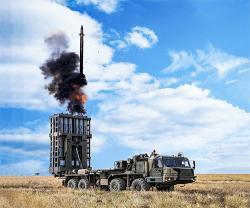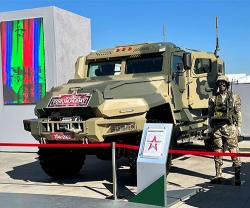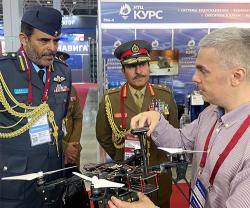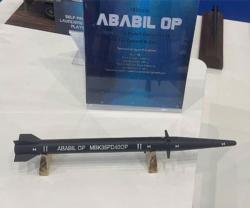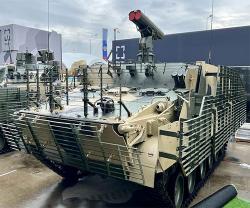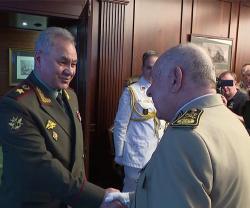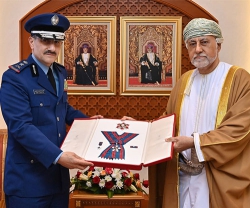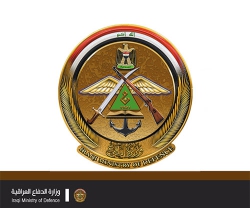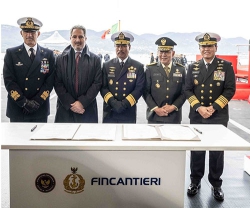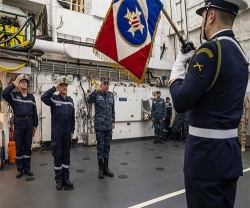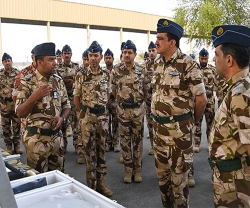By Sergey Kirshin, Yuri Laskin (Al Defaiya), all photos - Yuri Laskin (Al Defaiya)
Monday, 10 July 2011 10:24
The fifth International Maritime Defense Show (IMDS) was held from 29 June to 03 July 2011 in Russia’s naval capital Saint- Petersburg.
Backed by full Government support, the show hosted 409 enterprises from 30 countries including 71 foreign companies with a total space over 15,000 sq.m. 15 large naval vessels including frigates, corvettes and submarine teamed with 29 crafts were docked at the LenExpo facilities. The Show was attended by 91 official delegations from 68 countries.
The biennial event consisted of international exhibition, scientific conferences, attendance of the enterprises of military-industrial complex and major demonstrations of naval technologies and fair public show. The IMDS main goal - to support the business cooperation in maritime and naval enterprises – has been fulfilled. Russia presented its latest ships, submarines, aircraft and fast boats of the Navy, Coast Guard and Emergency. The Russian Air Force aerobatic teams demonstrate their flying skills in the sky over the harbor.
Two main factors have been of great influence on the show. Earlier this year the Russian MoD unveiled a massive 10-year State Procurement Plan worth the equivalent of around US$700 billion which in particular included construction of 100+ ships. This was assessed by many experts as “a profound improvement in the Russian Navy’s fortunes”.
The Plan provides industries with a long awaited financial stability and also to help the Russia’s naval export sales. MoD re-gaining its status of a major Customer for national defense industries clearly shows that they would not be ready to buy “anything developed by the industries”. The internal defense market is not a closed system anymore. The national companies will have to offer competitive products and fight for orders. The industries will hardly be able to satisfy Defense Ministry’s growing requirements without restructure. The Government on the one hand shows readiness to invest heavily in most important and promising companies. On the other hand the Kremlin calls industries to co-invest and improve technological level by cooperation with advanced foreign industries. In these regards Russian companies consider export as the best way to draw additional financial resources for modernizing and international exhibitions as the optimal place to demonstrate their potential and to establish business connections.
The second factor was the Russian-French Mistral deal. On 25 January 2011 the Franco-Russian intergovernmental agreement was concluded for the supply of four Mistral/BPC-type force projection & command vessels. On June 17, 2011 at the St. Petersburg International Economic Forum Russian defense export agency Rosoboronexport signed a contract with DCNS for two Mistral/BPC ships and associated services including initial logistics, training, and the transfer of technologies. The ceremony was attended by the RF President Dmitry Medvedev. For the contract worth over 1 billion Euro. DCNS will act as a prime contractor and will also integrate the operations direction and communication systems. The shipbuilding of platforms will be subcontracted to the STX shipyard at Saint-Nazaire in western France assisted by Russian United Shipbuilding Corporation (USC). A subcontract has been signed by STX and USC. The first ship will be delivered to Russia in 2014. The second BPC will be delivered in 2015. According to the USC President Roman Trotsenko, the USC Admiralty Shipyards is to build the stern part of both ships to be transmitted to Saint-Nazaire for final assembling.
This was Russia’s the first ever purchase of military equipment from a NATO member which required months long negotiations – talks which however have been mired by disputes over technology transfer. The deal also initiated quarrels and discussions in Russia on the necessity and reasonability of the deal itself. Majority of politicians and experts however agreed that Mistral delivery will bring evident political profits to Russia and will be helpful in the process of deep modernization of the Russian industries. Russia decided to buy Mistral ships from France because it would have taken at least 10 years to develop a similar domestic model, Chief of the Russian General Staff Gen. Nikolai Makarov said. He added, Russia should buy the best of modern weaponry abroad to be built under license in Russia.
Rosoboronexport General Director Anatoly Isaikin mentioned that France had agreed to transfer sensitive technologies following a Russian demand which prolonged negotiations. Russia has been keen to receive an advance naval operational tactical information system SENIT-9 from France as part of the package. Isaikin said that, although the first two ships would be built in France, a third and fourth should be bought and would be built in Russia. The MoD should give clarifications for date for that part of the project.
According to the Russian Navy C-in-C Vladimir Vysotsky shipbuilding technologies applied in Mistral will enable integration of the Russian-design systems including armaments, landing equipment and ship-borne aviation. France also agreed to modify design for Russian use with stronger bows (for operation in ice) and larger hangers (to fit Kamov helicopters).
After the contract on Mistral is signed other important challenges have to be met. French subsystems of the ship should be adapted to the Russian standards and naval requirements. As was mentioned in the Russia media several companies from the Russian shipbuilding industry have already been determined to establish partnerships with their French counterparts. In particular, Ulyanovsk-based NPO Mars, a member of Morinformsystem-Agat Concern, will cooperate with the French Thales on the Combat Management System’s adaptation, St.-Petersburg Transas will adapt navigation equipment in cooperation with the French Sagem. According to the press both Avrora and Granit-Electron Concerns will be heavily involved in the C4I integration process.
In general this large-scale contract should create pre-requisites for cooperation for example on advanced tactical control systems. The message that Russia can be a market for defense products and technologies from abroad led not only to increase of foreign participants. There was an evidence of growth in a number of Russian companies offering products of their international partners. In particular Technopole company demonstrated sonar and navigation equipment for submarines and surface ships of the French IXBLUE and German ELAS Nautik. Russian MKB Compass and Norwegian L-3 Communications Valmarine AS signed a Protocol on intentions and jointly exhibited Norwegian automation control systems for combat ships and commercial vessels, in particular the Valmarine Platinum ship’s Integrated Automation System of the 4-th generation. The US PTC which shared stand with Russian Irisoft confirmed plans to participate in the development of software for manufacture of the French Mistrals both at French and Russian shipyards. PTC can offer its experience in arranging compatibility of all subsystems of the ships with Russian standards.
Despite the deal on Mistral Russia is predominantly an exporting nation. The recent report stated that Russian armament industries exported over USD 10 billion of weapons last year, surpassing original estimates.
According to Mikhail Dmitriyev, Director of the Federal Service for Military-Technical Cooperation (FSVTS), Russia set a new record exceeding the target level of $9.5 billion. Meanwhile, the order portfolio of the Russian defense industry increased substantially to $48 billion mainly due to the sakes by the main Russian state armament exporter, Rosoboronexport.
"Generally speaking, I'm sure we can meet the demands of foreign clients, but to some extent and volume," Dmitriyev said. "The fact that we keep increasing the volume, makes this issue extremely relevant, because it simultaneously increases state defense orders. And now there are large orders from Russia's armed forces, which of course take precedence."
The FSVTS Head went on to explain that as state defense orders continue to increase, the production capacity is naturally limited or in some cases even reduced. Now Russia is faced with the "need to increase production capacity" in order to meet domestic and foreign demand for Russian armaments. But with Russian military exports at record highs, there should be no lack of funds to support the research and development of homegrown military hardware. Russia lists ten countries - in the Asia-Pacific region, North Africa, Middle East and Latin America - that account for the bulk of its military-trade co-operation while India remains the biggest customer of Russian military hardware.
The largest exhibition space was covered by the United Shipbuidling Corporation – the state-owned shipbuilding giant comprising almost all design bureaus and plants in the final surface vessels and submarines construction including Rubin, Severnoye, Almaz, Malakhit, Nevskoye Design bureaus as well as Admiralty shipyards, Sevmash, Yantar, Zvezdochka, Zelenodolsk shipbuilding plants among the others. The USC President Roman Trotsenko mentioned the Corporation was going to give the Russian shipbuilding a new strong breath through the latest technology application and modern management. The USC was also a major news maker at the exhibition. During the Show the Rosoboronexport – USC team signed a deal with Algeria to build two new Tiger class corvettes (Project 20382 – export version of the Project 20380 corvettes of the Russian Navy). Trotsenko also disclosed another contract signed by the team to sell three light Molniya missile corvettes to an unspecified ex-Soviet Republic. He said the contracts signed at the show exceeded USD 1.3 billion.
The USC enterprises had been able to report on a number of achievements for both domestic and export spheres.
Admiralty shipyards have been implementing contract on manufacture of six Rubin-design Kilo class diesel-electric submarines for the Vietnamese navy with a contract worth 1.8 billion dollars signed by Rosoboronexport. Admiralty shipyards are also contracted for the construction of Project 636M submarines for the Russian Navy. Experts mention that 5-6 submarines will be built for the Black sea fleet.
The Kilo Class submarines were designed for anti-submarine and anti-ship warfare in the protection of naval bases, coastal installations and sea lanes, and also for general reconnaissance and patrol missions. The Kilo is considered to be one of the quietest diesel submarines in the world. The submarine consists of six watertight compartments separated by transverse bulkheads in a pressurized double-hull.
Modernized Talwar class frigates of Project 11356 for the Indian Navy based on the Severnoye Bureau design are under construction at the Yantar Shipyard in Kaliningrad. Three ships of the first series were built and delivered to the Indian Navy in 2003 and 2004.The ships of the class got a high assessment from the Customer and it became a justification for a new contract for the second series. The ships of the second series, with three as well, are equipped with the Russian-Indian missile system of BrahMos. The fifth ship Tarkash and the sixth Trikand were launched on June 23, 2010 and May 25, 2011 respectively to be delivered to the customer in 2011 and 2012.
But Yantar is not purely working for export. The first Guard ship Admiral Grigorovitch (Project 11356) for the Russian Navy was laid down on 18 Dec 2010. According to Vladimir Vysotsky not less than 5 such frigates to join Black Sea Fleet by 2015.
USC –owned Zelenodolsk Shipyard based in the Russia’s Republic of Tatarstan just floated out a second Gepard class frigate for the Russian Navy. The ship titled Dagestan is expected to join the Caspian Flotilla in 2011. Its sister ship Tatarstan has been serving as the Caspian Flotilla flagship since 2002. The ship has a displacement of 2,000 tons, a length of 102 meters, a maximum speed of 23 knots, a crew of 103 personnel and a cruising range of 5,000 miles. The frigate is armed with the Uran-E anti-ship missile system, a 76.2-mm gun mount AK-176M, a Palma air defense artillery system, two 30-mm gun mounts AK-630M, and 533-mm torpedo tubes. It can carry a Ka-28 or a Ka-31 Helix naval helicopter.
Recently Zelenodolsk shipyard passed to the Vietnamese Navy the second frigate of the Gepard export version (Project 11661). Frigate was loaded onboard a specialized transport ship on May 25 which should reach Vietnam within July. Earlier this year there was an official ceremony in Cam Ran base of hoisting state flag of Vietnam on the first frigate of the series. Gepards for Vietnam are manufactured in line with Stealth technology, armed with Palma-SU AD system with new optical-electronic guidance system, as well as with Uran missile system.
Sevmash has been completing implementation of the largest international contract – repair and refurbishment of the Vikramaditya aircraft carrier for the Indian Navy. The Shipyard was assigned for the job to transfer the ex-Soviet Admiral Gorshkov cruiser into an Indian aircraft carrier in 2004. It turned out that the Enterprise shipbuilders would have to build the new ship with application of the latest technologies, to fit the repaired hull with advanced systems and equipment. In particular the flight deck was extended till 283 m, the bow was equipped with a springboard for MiG-29K ship-borne fighters’ take offs. Aircraft carrier was equipped with three cable-type arresting gears. Two lifts should have been tested to bring the aircraft from the bottom deck to the upper one. The optical aircraft decking system was to be installed too. The ship’s electronic armament must be also improved. Vikramaditya is to receive the latest navigation, radar, C4I systems. Thus the ship is to leave the Sevmash water area will be a brand new one. Both sides agreed that the aircraft carrier will start sea trials off the Russian coast by November this year to be delivered to India in December 2012.
The construction of the Border guard ship of Project 22460 based on the Severnoye Bureau design for the RF Border Guard Service was completed at the Almaz shipyard in Saint Petersburg. The lead ship Rubin was commissioned and the first ship in the series was laid down on 12 May 2010.
As a mark of the Russian-Indian defense cooperation, the Indian Navy frigate class lead ship Shivalik (Project 17) was completed at Mazagon Dock Ltd. in Mumbai. The design and construction of the ship was performed under technical assistant provided by Severnoye Bureau specialists. The ship was commissioned on April 21, 2010. It is planned to be commissioned the follow-on ships of the series Satpura and Sahyadri in 2011.
While almost all design bureaus have been brought under the USC umbrella, several remarkable shipyards haven’t yet become USC members. Among them Severnaya Verf, Baltiysky Zavod in St.-Petersburg as well as Rybinsk-based Vympel.
Multi-purpose frigates of Project 22350 for the Russian Navy based on the Severnoye Bureau design are under construction at the Severnaya Verf, among them the lead ship Admiral Gorshkov and the first ship of the series Admiral Kasatonov. The lead ship was launched on October 29, 2010.
In early March 2011 Severnaya Verf delivered the modernized Mourad class corvette, Rais Kellich and the Nanuchka II class FAC, Rais Ali back to the Algerian National Navy after a two year plus refit.
The Rais Kellich began its modernization in December 2008 and had its Strut Curve air search radar and the Hawk Screech fire control radar replaced with the Positive ME1.2. The new electronic warfare (EW) suite consists of the Watch Dog and Cross Loop ESM systems and PK-16 chaff launchers. The ship also was fitted with enhanced ASW capabilities including two twin 53cm torpedo tubes and the RBU-6000 rocket launcher/RPK-8 Zapad anti-submarine rockets. Four quadruple Kh-35 Uran (SS-N-25 Switchblade) ASMs replaced the four P-20 Termit (SS-N-2C Styx) ASMs. Two of three units have now been refurbished with the last unit, Rais Korfou, beginning by the end of 2011.
Vympel Shipyard confirmed the status of Russia’s leading shipyard building medium-tonnage and light sea- and inland waters vessels and boats intended for diverse naval and commercial applications. Nowadays Vympel Shipyard JSC offers for sale more than ten various-purpose ship projects, among them Molniya missile boat (Project 12418/ 12421), fast patrol boats Mirage (Project 14310) and Mangust (Project 12150) (their speed exceeding 50 knots), fire-fighting vessels and inshore tugs.
The IMDS guests were granted the opportunity to get acquainted with the materials and detailed scaled models of Morinformsystem-Agat Club-M Coastal Missile System, Club-U Modular Missile System, UKSK Universal Ship’s Firing System and also Varyag Integrated Multi-Purpose Ship’s (formation) Control System. Apart from the extensive exposition in the pavilion there was the open exposition where were demonstrated for the first time the full-size models of the most advanced Club-K Container Missile System in two configuration versions: 40-feet container with the 3М-54КE, 3М-54КE1 and 3М-14КE missiles; 20-feet container with the Kh-35UE missiles.
R.E.T. Kronshtadt, a member of Transas Group – has been completing the assembly in Vietnam of Laguna-11661 shiphandling simulator for training crews and combat teams of the Gepard-type corvettes manufactured by Zelenodolsk shipyard. This is a very complex system which includes 56 working seats, 7 combat unites and operating in the three regimes.
Earlier Kronshtadt developed for Vietnam a shiphandling simulator for the Molniya missile boats. For the Vietnamese customer Kronshtadt is also participating as subcontractor of Avrora Concern in the development of simulator for Pr.636 submarines.
Kronshtadt also hopes to start shortly development of simulator for the Navy of Turkmenistan which ordered in Russia two missile boats of Molniya type.
General director of Kronshtadt Eugene Komrakov sees a great potential of developing business in receiving orders from Russian Defense Ministry which is not so far active in placing orders for training systems.
MKB Compass developed a mobile complex for basing surface ships and submarines which enables to deploy bases within short time frame at shorelines’ sectors possessing no infrastructure. Deployment can be conducted within 15-30 days. Autonomous basing point enables to ensure not only mooring of the ships but their technical servicing, energy supply as well. The Complex will enable to conduct combat training of crews and ensure take off, landing and technical support of helicopters. The Complex can be of interest for Naval Forces, as well for civilian organizations involved in servicing ships in the Arctic.
The new IMDS dates were set up on June, 26-30, 2013. If the existing tendency on the Show development remains, IMDS has all the chances to become the largest meeting point of the international naval community.

